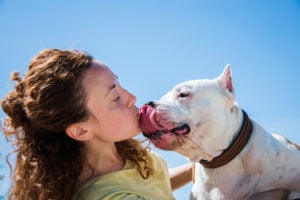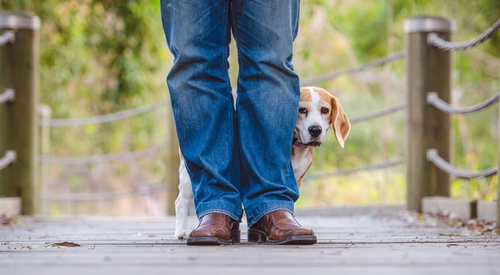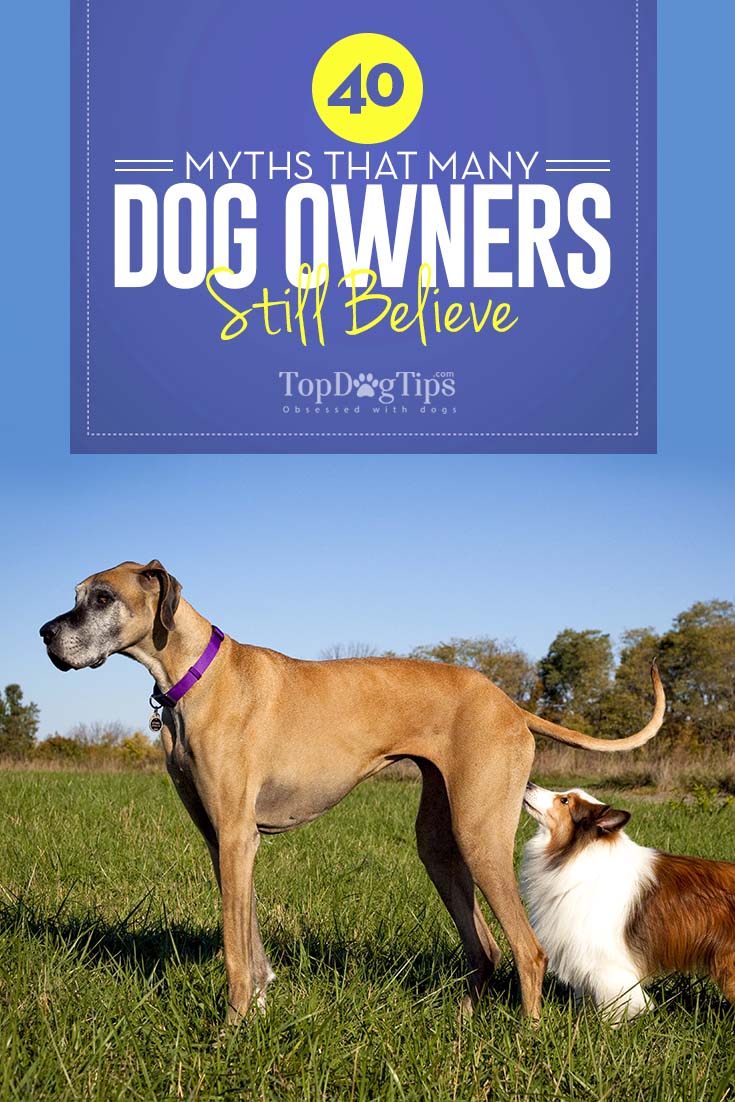Myths abound in the dog world and today, we’re looking at some of the most popular ones that many of us pet owners still may believe. Think you know your stuff? I bet you still think a few of these are factually true. Take a look at these 30 myths and see how many you believed.
For this article, I've gone through a lot of legends and myths related to dog ownership, and then researched them further by checking on what veterinarians, scientists and other reputable sources have to say and what evidence they have to backup these claims.
 It turns out, a whole lot of what we were led to believe is simply… not true.
It turns out, a whole lot of what we were led to believe is simply… not true.
As dog owners, it's our responsibility to understand our animals' behavior and not buy into all the myths that circulate in the dog community. It's our responsibility to educate ourselves in order to provide the best possible care for our dogs. If you believe myths, like those about canine aggression, you could put you, your pet, other people and pets at risk.
Keep a tally as you read through this list. I bet you'll be surprised at how many of these myths you used to believe. Next time you make a decision based on what you've heard, remember to do the research and find what's actually true, and what's a myth.
ALSO READ: 27 Questions to Ask Yourself to Know If You’re Ready for a Dog
30 Myths That Many Dog Owners Still Believe
1. You can’t teach an old dog new tricks
Actually, dogs are continually learning and can continue to learn new tricks up until their last days. In fact, teaching older dogs new tricks can help to keep their mind sharp!
“The conclusion that can be reached from this research is that you can teach an old dog new tricks, only it'll take longer than it takes a young dog — however, once that old dog has learned he will remember these new things over the long-term.” says Stanley Coren, PhD (source)
2. Dogs tell us when they’re sick
Dogs try to hide when they're feeling under the weather out of natural instinct. Being unwell makes an animal weaker which, in the wild, would be a sign to predators that they were an easy target.
As dog owners, however, we become aware of our dog’s normal behavior patterns. When these behavior patterns are “off” we can tell, and this is how many owners know when their dog is under the weather!
3. Every dog should have a litter before being spayed
Dogs do not need to have a litter for any reason. In fact, with so many animals being put to sleep every day, there is no reason at all for your dog to have a litter of her own.
However, spaying or neutering too early can affect your dog's health. Even if your veterinarian says it won't harm your animal, new research on when to spay or neuter your pet is something you consider before making the decision. Spaying can vastly reduce your dog’s chances of numerous serious illnesses and lengthen her lifespan; however, for some dogs, there a number of potential risk factors to consider and this procedure can be disadvantageous as well, according to vets.
“Before neutering an owned animal, a veterinarian should take into account the pet’s breed and its genetic predisposition to particular diseases,” says Dr. Philip A. Bushby, DVM (source)
4. A “good dog” won’t bite
A well-trained dog with a loving family that has never shown signs of aggression can bite just as easily as any other dog. There's a vast amount of scientific research on why this happens, and factors vary.
Dogs bite for many reasons, including when they are startled or surprised, when they feel cornered, or when they are defending their territory or loved ones. A dog does not have to be a “mean dog” to bite.
5. Dogs should not be allowed to bark
Our dogs bark as a method of communication as well as for many other reasons. When we discourage barking, we discourage them from communicating and “doing their thing.”
Dogs should be trained to recognize when barking is and is not appropriate, but they should never be “de-barked” or prohibited from barking altogether. While there's a number of methods, techniques and tools to solve barking problems, using things like dog barking collars is not advisable and should be done only as the absolute last resort.
“These initial studies show that growls and barks do carry meaning that other dogs and, in some cases, people can recognize,” says Prof. Brian Hare (source)
6. One dog year is seven human years
Assuming one dog year is seven human years simply doesn’t make sense based on the wide variety of dog breeds and sizes, as well as all the research done to date.
The rate at which your dog ages differs based on his size most of all, with larger dogs aging at a faster rate than smaller dogs. Some dog breeds also have a longer lifespan.
7. Mean dogs growl
ALL dogs growl. Just like barking, growling is a method of communication that our dogs use to warn us of danger, to scare away something they perceive as a threat, and to communicate their irritation with a situation or individual.
Growling does not mean that a dog is “mean” or even aggressive. It means that a dog is trying to convey a message, and that message should always be heeded. There are also different types of growling of dogs, and scientists have looked into that as well.
“There was a clear significant difference between the play growl and the two others, which we call agonistic,” says researcher Peter Pongracz (source)
8. A dog that’s wagging his tail is happy
Dogs wag their tails for many reasons and different posturing of the wagging tail has different meanings, according to researchers who have studied this for years.
While dogs may wag their tail because they are happy, dogs may also wag their tail when they’re fearful, on guard, or prior to biting. Therefore, it's important to understand and learn about your dog's body language to know what he's communicating.
9. A dog’s mouth is cleaner than a human’s
 This is one of the largest myths of all. There has been no study to date that can conclusively show that a dog’s mouth is cleaner than a human’s.
This is one of the largest myths of all. There has been no study to date that can conclusively show that a dog’s mouth is cleaner than a human’s.
Dog mouths and human mouths both harbor bacteria, albeit different types, which makes neither particularly clean! Also, if you think where dogs usually put their mouths, there should probably be a very strong argument against this commonly popular myth.
Snopes.com has looked into this much further, and they have concluded that this questions cannot be answer currently for the following reasons:
“If by “cleaner” one means “less harmful,” a physical count of the fauna present wouldn’t yield useful results, because some sorts of relatively benign bacteria colonize rapidly and widely, while some of the truly nasty ones produce rather small colonies of growth.”
10. Destructive behavior when you’re not home is a sign of spite
Dogs that exhibit destructive behavior when you are not home do that not out of spite; rather, it is a sign of fear, anxiety, or boredom your dog is experiencing.
Fear of being away from you (better known as separation anxiety), anxiety over noises outside, or pent-up energy and boredom can all lead to behaviors like chewing furniture, emptying trashcans, and tearing up clothing.
Instead of getting angry at your dog, find dog-friendly ways how to prevent your pet from experiencing anxiety and how to make sure he doesn't chew up your furniture.
11. An adventurous puppy is the best pick of the litter
A well-rounded puppy in any litter should show signs of being adventurous because that's what healthy puppies do. However, a puppy should also have a healthy level of caution.
A puppy that is too adventurous to the extreme levels is just as unhealthy as a puppy that is too shy, and there may be something that needs to be looked into.
12. Table scraps are fine for a dog to eat
“When I was a kid, my dog ate nothing but table scraps and…”
This is a particularly common statement, but it does not mean that table scraps are the best food for a dog just because this how the things worked back in the day. Myths about what dogs should eat and what they should not eat are some of the most popular.
Today we know a lot more about proper dog nutrition and how to feed our dogs. Like humans, dogs need a balanced and healthy diet that is optimized for their unique needs.
13. Dogs don’t see in color
Can dogs see in color? Yes, absolutely. Why wouldn't they be able to see in color?
Numerous studies have revealed that dogs are capable of seeing various colors. While dogs have fewer color receptors in the eye than humans do, they are still capable of perceiving grays, blues, and yellows. They certainly do not see the world in black and white.
14. Your dog must see you as “alpha”
This myth has long been propagated among dog trainers, and its popularity origins are attributed to Cesar Millan. However, the dog training research has reveal over and over that dogs do not need to be dominated to be well behaved and secure.
In fact, dogs that have parental figures who provide stability, positive reinforcement, and praise without dominating are more well balanced and happier dogs overall.
“The debate has its roots in 1940s studies of captive wolves gathered from various places that, when forced to live together, naturally competed for status,” says Bonnie Beaver, former president of AVMA (read more)
15. Food will motivate any dog
 Some dogs will do absolutely anything for a tasty dog treat, but contrary to popular belief, not all dogs will and not all animals will be motivated by food.
Some dogs will do absolutely anything for a tasty dog treat, but contrary to popular belief, not all dogs will and not all animals will be motivated by food.
For some dogs (if they are receiving adequate nutrition from their regular diet) motivation lies in praise, dog toys, play time with the owner, or other stimulation instead. There are also several psychological training tricks that reveal more about this behavior.
In fact, a new study revealed that dogs are much smarter than we thought. They may hold off on the treat if they know that a better thing may come.
16. A dry nose means illness
Whether a dog’s nose is wet or dry has nothing to do with their overall health and it definitely does not mean that your dog may be ill or have a fever.
Most often the wetness of your dog’s nose has more to do with the environment and weather than anything else. Science shows that it's nothing more than that.
Wondering if your dog is sick? Get out a pet thermometer instead and check your pooch.
17. More baths means a cleaner dog
Some dog owners love to go the extra step and bathe their dog almost daily. Do not do that, and veterinarians warn against washing your dog too often.
Even though your intentions may be good, more frequent bathing may make your dog smell cleaner, but it can also cause problems in the long run. Too much bathing can create dry skin, an oily coat, or dandruff which can lead to other hygiene concerns. Finally, when bathing your dog, make sure you do it correctly.
18. Butt-scooting is a behavioral problem
You may think it's funny or cute, but 99% of the time butt-scooting in dogs means a health problem that should be treated by your veterinarian ASAP.
When a dog scoots their bottom on your carpet, it is almost always because they have parasites or their anal glands are full. Not treating this issue will results in more serious health problems down the road.
“If your pup is doing the dreaded scoot across the grass or your favorite Oriental rug, take heed. Chances are she’s trying to solve a problem with one or both anal glands,” says Dr Karen Becker, DVM (source)
19. Dogs that don’t go outside don’t need heartworm prevention
Most dogs need effective heartworm prevention; otherwise, you risk serious problems.
Heartworm prevention kills heartworms that are actively living in your dog at the time of medication. Heartworms are usually contracted via mosquito bites when infected mosquitoes transmit heartworm larvae onto your dog.
Since mosquitoes can infiltrate your home, it is entirely possible for a dog who has never been outdoors to contract heartworm disease as well. Also keep in mind that not all dog dewormers are the same, so make sure you get the right solution.
20. “It’s all in how you raise them…”
 Well-meaning dog owners defend dogs by claiming that their behavior depends on how dogs are raised. Despite good intentions, however, this simply isn’t true.
Well-meaning dog owners defend dogs by claiming that their behavior depends on how dogs are raised. Despite good intentions, however, this simply isn’t true.
There are many examples of dogs that have been used in dog fighting who have gone on to loving homes where they exhibit no aggressive behavior whatsoever. A good example of this are Michael Vick's dogs (read more about them).
21. Some dog breeds are just aggressive
Like humans, all dogs have the potential of being aggressive. This aggression is the culmination of many different factors including genetics, human training, past experience, and that particular dog's personality.
While individual dogs of a certain breed can be aggressive, it is not always the dog’s breed that makes it aggressive, or at least to that level of aggressiveness. In fact, many other factors will always be the reason over dog's breed, according to a new study.
“It is important for dog owners and members of the public to be aware that any dog is capable of showing aggression, even where it has not done so in other situations,” said researchers of the above Bristol study (source)
22. “It feels cool enough outside, my dog will be fine in the car”
While the temperature outside may feel fine to you, the temperature inside your car climbs rapidly and exponentially. After just 30 minutes on a 70-degree day, your car will reach a deadly 104 degrees Fahrenheit, even with the windows cracked.
Moreover, dogs are not humans, and they control their body temperature differently. That means what feels too hot or too cold for you may not be for your dog. As a result, most US states have now banned leaving dogs in cars altogether.
Watch this video for a better visual explanation:
23. Don’t allow your dog to hide behind you in fear
Many dog owners are told that they should not allow their dog to hide behind them when he is afraid. However, forcing a dog to come out of hiding and face their fear can be more detrimental to your dog's psychology and both of your relationship.
Research shows that this practice will eliminate your dog's trust in you. Therefore, rather than being forceful or being complacent about your dog’s fear, gently work with him over time to desensitize him to whatever he is afraid of, and use proper dog training methods.
24. Dog poop will fertilize the yard
Not only this isn't true, but actually the exact opposite has been proven by research.
While cow manure is an excellent fertilizer, dog poop on the other hand does not have the same makeup due to Fido’s diet. A diet high in protein makes for very acidic poop, which is not hospitable to growing anything.
There has been tons of studies on how dog feces contaminate the soil and pollute the environment, which is why dog owners are strongly encouraged to use pooper scoopers and dog poop bags and always, always clean up after their dogs.
“Feed made from chickens and rabbits has a far less negative effect on the environment than feed from cud-chewing ruminants; I can easily swap out lamb for a more benign meat source,” write LA Times.
25. Dogs don’t need a coat in the winter
This is partially true, but not completely.
Healthy dogs with a thick coat do not need a coat in the winter (of course, depends how cold the winter actually is – Antarctica may be too cold for most breeds).
However, smaller dogs and/or dogs with a low body weight, slender-built dogs, sick dogs, older dogs, puppies, and dogs with conditions that compromise their body’s ability to keep warm should all wear doggy coats in freezing temperatures.
26. A fearful dog must have been abused in the past
 Although that may be the case sometimes, it's not a rule. Some fearful dogs have had a very safe home life, and yet they still suffer from different fears and phobias.
Although that may be the case sometimes, it's not a rule. Some fearful dogs have had a very safe home life, and yet they still suffer from different fears and phobias.
There are many factors that go into developing fears, and abuse is just one of them. For example, a well-loved dog who has had limited social exposure can develop a fear of people despite being loved and well treated. It's because the dog simply doesn't fully understand the world around him.
Even though there are many different methods to deal with fearful and particularly anxious dogs, such as anxiety vets or anxiety medication, plenty of research now show that comforting your dog and continued training may be the best option for everybody.
“When dogs meet with a stressful situation, their overall anxiety level is decreased when their trusted humans are nearby. Further, when this is the case, our presence in these situations has a protective effect for future exposure to stress,” writes Lorrie Shaw about the dog behavioral study (source)
27. “My dog is shaking because he is cold”
 It is true that a dog may shake because he is cold, but there are many other reasons that dogs shake as well. For example, dogs also shake when they are fearful, anxious, when they are in pain, or when they are particularly excited.
It is true that a dog may shake because he is cold, but there are many other reasons that dogs shake as well. For example, dogs also shake when they are fearful, anxious, when they are in pain, or when they are particularly excited.
To understand why your dog is shaking, you have to look at the circumstances under which he is shaking, and analyze the environment. Is it cold or are there fireworks going off? Is he injured or have you just returned home? Use common sense to understand it.
28. A puppy will perk up a senior dog
Whether or not a puppy will perk up your senior dog has everything to do with your dog’s personality and also the way either dog has been trained.
By default, some senior dogs are in pain with arthritis and the last thing they want is a young puppy pouncing on them all day. Some senior dogs enjoy the presence of another dog and still have the energy to keep up with a puppy.
29. Dogs don't get fleas and ticks in winter time
It's true only partially. When the cold weather sets in, we see fewer fleas and ticks because many of them die off.
However, some fleas and ticks can survive by seeking out warm hiding places. Those surviving critters can then attach themselves to your dog and feast freely even in winter.
Keep your dog protected against fleas and ticks all year round using well-proven flea treatments for dogs, and make sure you know how to remove a tick from your dog when needed.
30. Mutts are always healthier than purebreds
I kept this one for last. Saying that mutts are healthier dogs than purebreds is like saying that Londoners are healthier than New Yorkers.
Research clearly shows that there are many factors that go into determining how healthy a dog is, including genetics, environment, and proper dog care.

In some specific cases, data showed that purebreds will have genetic disorders, but the reason is because that's the only factor the study analyzed and obvious that breed will have that specific issue. This study suffered from so-called Texas sharpshooter fallacy.
For all other health factors in dogs, this is simply not true. In fact, the dog's size will be a far more important determining health factor than mutt vs purebred debate.
In terms of lifespan, one mixed breed may live longer than another purebred dog, but it is impossible to make such a sweeping generalization as to say all mutts will always be healthier than all purebreds, and vets and scientists agree on this.
READ NEXT: 5 Benefits of Elevated Food Bowls for Dogs – Myths or Facts?














